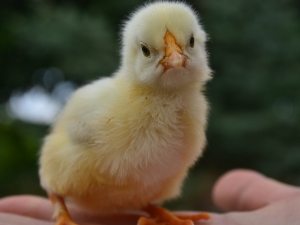
Chickens are pretty healthy and resilient birds. These animals can live for many years without getting ill. However, if your birds aren’t living in the healthiest of conditions then they can become sick.
If your baby chick has a swollen bottom you’d understandably be worried. So, why does this happen? This article looks into it
If your chick has a swollen red bottom rather than a normal-looking uninflamed bottom, then the bird is likely suffering from vent gleet.
Table of Contents
Baby chick with swollen bottom
Baby chick bottoms are supposed to be pink, moist, have no inflammation, discoloration, or dirt on them. If you lift the bird up to look at its bottom, and it’s inflamed then your bird is likely sick with vent gleet
Vent gleet is a fungal yeast infection that can affect your birds. Other names for this illness include thrush.
If there is a ph imbalance in your bird’s digestive tract, and thus, growth of bad bacteria in the area, then your bird will begin to suffer from vent gleet.
Other signs:
One sign of vent gleet is redness and swelling in the bird’s vent area. Other signs of vent gleet in your birds include missing feathers around your bird’s vent area, pasted-up feathers around the vent, and a white discharge from the vent.
This discharge will have a foul smell. Your chick may have developed vent gleet as a result of stress, a lack of clean water, or eating moldy feed
What to do:
You’d need to get good bacteria into your chick using probiotics, treat the bird until you see the swelling on your chick’s bottom going down and the other symptoms going away too. This should happen within a couple of days.
Warning: Do not try to cure vent gleet with antibiotics, yes antibiotics will kill the bad bacteria that causes vent gleet, but it will also kill off any good bacteria in your bird. This isn’t helpful, it can actually make matters worse.
It is also recommended that you bathe the bird in clean, warm, and salty water to help the swelling go down and clean the area. You can also do a molasses flush on the bird.
If you don’t treat vent gleet in time, it can develop into something fatal. While vent gleet itself isn’t fatal, it can spread to the rest of the bird’s body and turn into sour crop, this illness is more difficult to treat. Read more about sour crop here
Avoiding this in the future:
Vent gleet is not contagious but if your other flock members live in the same conditions that caused your sick bird to become sick then other flock members will also become ill if you don’t change the conditions.
You can avoid the development of vent gleet in your other birds by making sure that you always have clean, fresh water available for your birds, getting rid of foods that are old and wet, giving your birds daily doses of probiotics, and giving unflavored plain yogurt to your birds as treats.
If you notice that your other chicks are starting to develop a swollen bottom, then you’d need to treat this as soon as you notice it.
What else can go wrong with my chicks bottom?
Vent Prolapse: This develops when the bird’s inner tissue protrudes out of the bird’s vent and becomes exposed. This is very painful and dangerous to birds but is easily treatable especially in the earlier stages
Pasty butt: Pasty butt happens when the bird’s feces plugs its vent. As the bird tries to pass excrement, the blockage prevents the feces from moving out of the vent which creates an even bigger blockage.
Lice and mites: Lice and mites infections are common with chickens, these parasites usually congregate around the bird’s bottom.
FAQ’s
How to treat chickens with dirty bottoms?
If your bird has a dirty bottom, and the animal seems to be having trouble cleaning its bottom itself then you can help the bird out.
Do this by gently cleaning the area with a solution of warm water and a mild detergent such as Dawn dishwashing soap.
The animal should be kept warm as you dry it off, letting the bird stay cold will stress the bird.
If your bird has vent gleet you may have to clean the vent over many days.
Can vent gleet go away on its own?
Vent gleet is a sign that there is something going wrong in your bird’s digestive tract, for this reason, the animal may not be able to clear this on their own. In this case you’ll have to help the animal clear the condition
You can treat the vent gleet in your pet chicken very easily, and, thankfully, this condition is not fatal in your bird
Conclusion
In conclusion, if your chick has a swollen bottom, then your bird may be suffering from vent gleet. Vent gleet can be treated by giving the bird probiotics.
Other vent issues that your bird can suffer from include pasty butt, vent prolapse, and parasitic infections.
If you enjoyed this article then you may also be interested in other chicken related articles. Here are some articles that you may be interested in: Red Spots On Chicken Legs, Chicken Has Dry Flaky Skin, Red Inflamed Skin On Chickens, Chicken Dandruff

